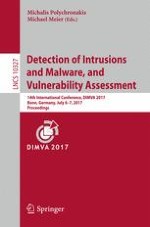2017 | OriginalPaper | Buchkapitel
Quincy: Detecting Host-Based Code Injection Attacks in Memory Dumps
verfasst von : Thomas Barabosch, Niklas Bergmann, Adrian Dombeck, Elmar Padilla
Erschienen in: Detection of Intrusions and Malware, and Vulnerability Assessment
Aktivieren Sie unsere intelligente Suche, um passende Fachinhalte oder Patente zu finden.
Wählen Sie Textabschnitte aus um mit Künstlicher Intelligenz passenden Patente zu finden. powered by
Markieren Sie Textabschnitte, um KI-gestützt weitere passende Inhalte zu finden. powered by
